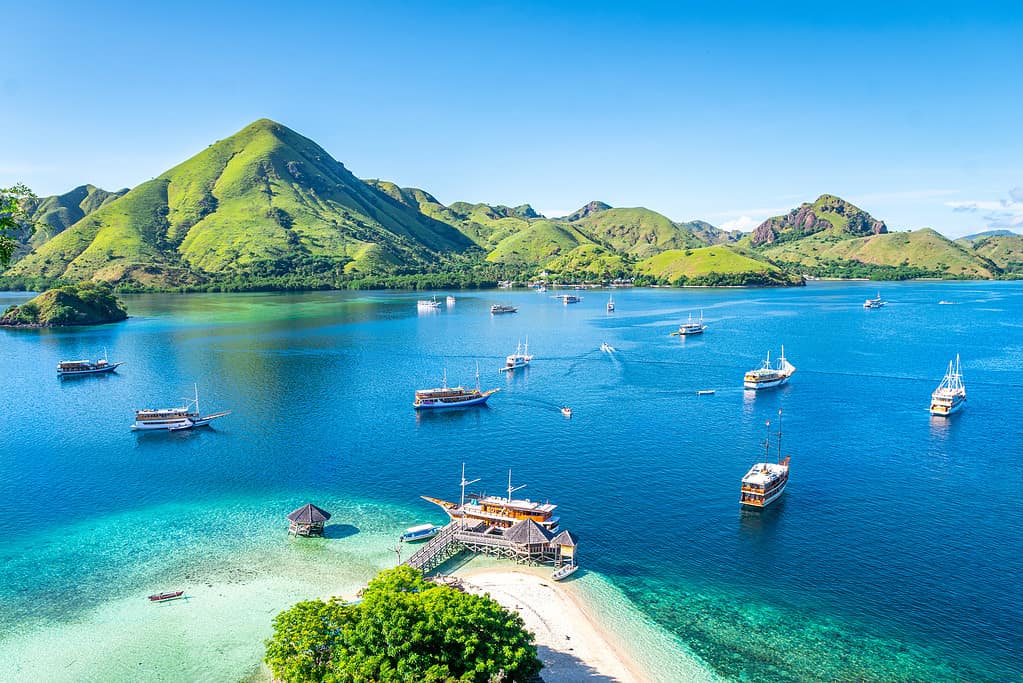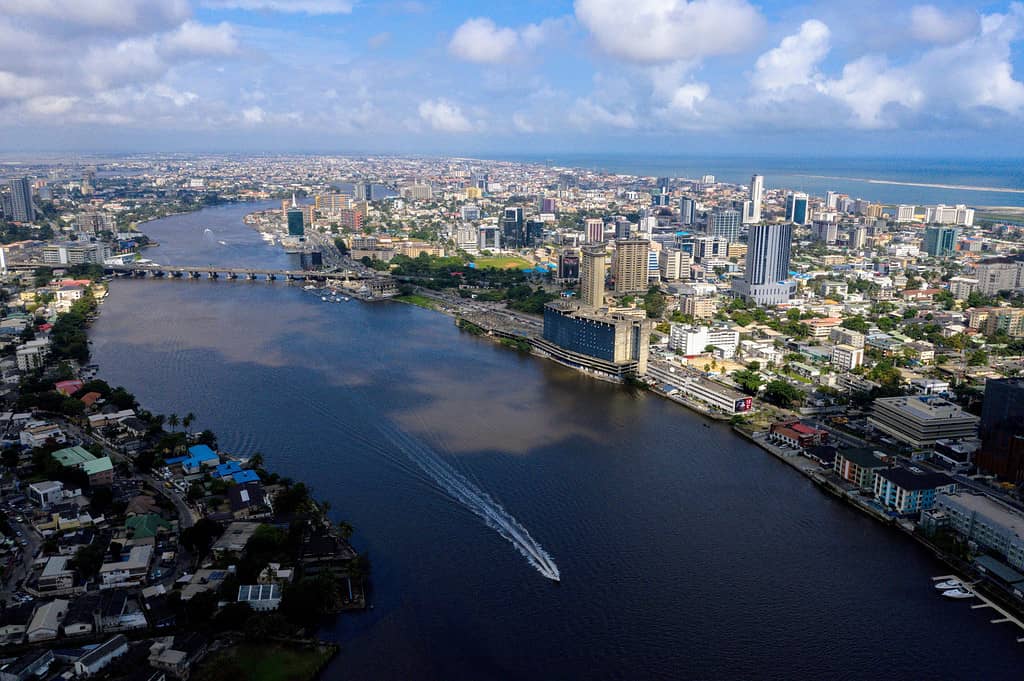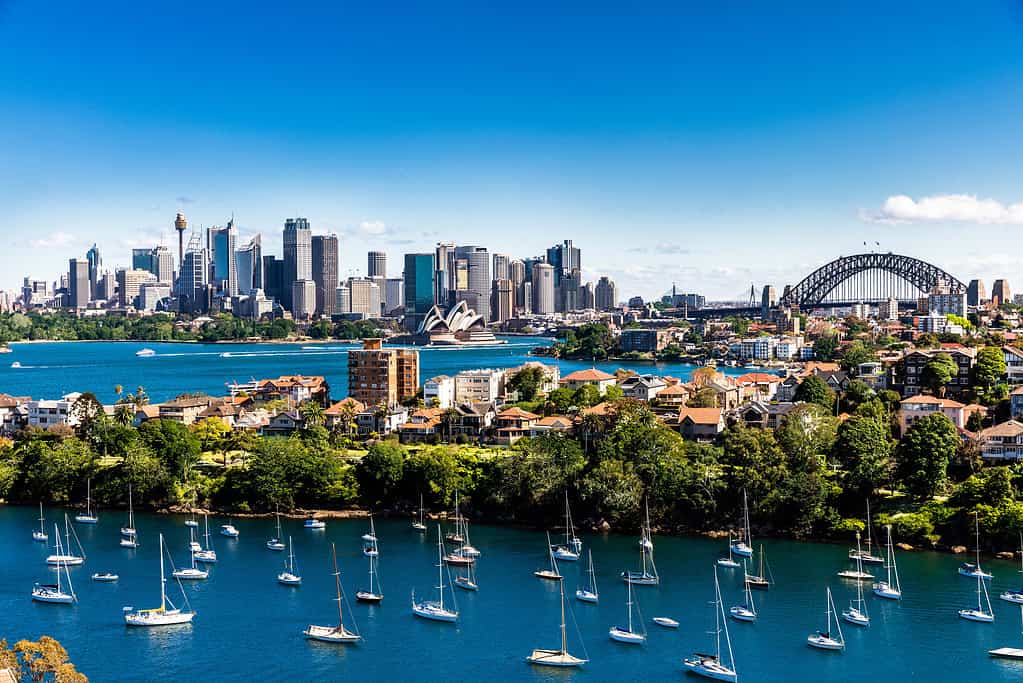Languages have existed for the longest time. According to some research, some began over 100,00 years ago and continue to develop and evolve since then. Linguists believe some languages may be even older than this but have gone extinct without leaving proof of existence.
Also, it is rare for countries to have only one language and not any regional or dialect. Decades of history, immigration, and colonization influence the presence of languages in a country. And it doesn’t matter how small! The Vatican City, the smallest country in the world, has two official languages, Latin and Italian. Language diversity is a treasure, and governments are working hard to preserve some of their endangered regional and Indigenous languages.
Keep reading to discover what are the countries with the most linguistic diversity!
1. Papua New Guinea – 840 languages

The country of Papua New Guinea is on the east side of the island of New Guinea and borders to the west with Indonesia.
©GenDeschenes/iStock via Getty Images
- Continent: Oceania / Australia
- Capital: Port Moresby
- Population (2021 estimate): 11,781,559
Papua New Guinea is a lesser-known country in the southwestern Pacific Ocean. But when talking about language diversity, this smaller nation has no competition with 840 languages spoken.
Nestled on the east side of New Guinea (the second largest island in the world), Papua New Guinea is home to hundreds of languages and ethnic groups, each with its traditions, customs, and social structures. It is one of the most intriguing places for linguists and cultural anthropologists.
According to Ethnologue and World Bank, Papua New Guinea is home to 840 languages, representing approximately 12% of the world’s total. Most of them belong to various language families, including Austronesia and Papuan, among others.
Papua New Guinea has five official languages. English, used for the government and the education system, is not spoken widely. Since 2015, Papua New Guinean Sign Language also became an official language in the country.
Tok Pisin (Melanesia Pidgin or New Guinean Pidgin) is the most widely spoken language on the island and became the country’s lingua franca (adopted as a common language between speakers with different native languages). This English-based creole is used for the Parliament debates, commerce, information campaigns, and the news with a national newspaper called Wantok.
In the southern region of Papua New Guinea, Tok Pisin isn’t prevalent, and the inhabitant speaks the third official language, Hiri Motu. Inhabitants in outlying and rural villages use Hiri Motu, while city inhabitants use Tok Pisin more.
Other Languages
Outside of these four official languages, Papua New Guinea is home to 836 more! One reason for this diversity is the country’s high isolation of some communities, leading to the development of multiple languages.
Enga is the most spoken Indigenous language — which isn’t recognized as official — with around 200,000 speakers, ahead of Melpa and Huli.
With an average of 7,000 speakers per language, Papua New Guinea has the second-largest density of languages behind Vanuatu. However, some of these Indigenous languages have fewer than 1,000 speakers. Globalization and the dominance of larger languages threaten some of Papua New Guinea’s native languages. The government tries to promote these languages’ documentation and preservation.
2. Indonesia – 712 languages

Indonesia has over 1,300 ethnic groups.
©jon chica parada/iStock via Getty Images
- Continent: Asia
- Capital: Jakarta
- Population (2023 estimate): 278,696,200
With more than 17,500 islands, Indonesia is the largest country in Southeast Asia. Like Papua New Guinea, it is famous for its remarkable linguistic diversity.
Indonesia, with a population of over 270 million, is home to approximately 1,300 distinct native ethnic groups. Most Indonesians descend from the Austronesian and Melanesian peoples. The Javanese, with 40.2% of the population, is the largest ethnic group, followed by the Sundanese, with 15.4%.
In Indonesia, there are 712 languages. These languages belong to various language families, mainly from Austronesian and Papuan. A significant reason for this linguistic diversity is the number of islands in the country; most are very isolated, and the communities have their own languages. It is also closely tied to cultural identity as different ethnic groups’s customs, rituals, and traditions are reflected in their languages.
Still, Indonesian or Bahasa Indonesia is the country’s official language. This standardized form of Malay serves as the lingua franca throughout the country. Nationalists in the 1920s promoted it, and its status became official in 1945 with the name Bahasa Indonesia. Its adoption had the goal of facilitating communication among the different ethnic groups. Its utilization is widespread in business, mass media, politics, and education. Local languages are sometimes taught first before Bahasa Indonesia in some remote and isolated islands or areas.
Other Languages
Bahasa Indonesia is only one out of 712 languages spoken in the country. Most of them belong to the Austronesian language family, and 270 of them are Papuan languages.
A large majority of inhabitants are multilingual. They speak one language or dialect at home, Bahasa Indonesia, for national communication and sometimes even English, especially in touristy regions. And most of the time, it highly depends on factors like ethnic groups and location.
Javanese is the most prominent language in Java, the most populous island. It is also the most widely spoken language outside of Bahasa Indonesia and has co-official status in the Special Region of Yogyakarta. The Balinese language is the primary language in Bali. In Sumatra, there are a lot of Minangkabau and Acehnese speakers.
In Eastern Indonesia, specifically in the Papua region (bordering Papua New Guinea), inhabitants speak a large variety of Papuan languages. Papuan languages are common for Indigenous Papuan communities. They are very distinct from the Austronesian language family primarily spoken in Indonesia.
Dutch colonialism played a significant role in the spread of Malay, now known as Bahasa Indonesia. Indonesia is also home to a small population of Dutch other Europeans — called Totok — Dutch-based creole languages are common in ethnic groups of descendants of Dutch colonizers. Fun fact: some specific law codes in Indonesia are still only available in Dutch!
With this many languages, efforts are made to document and preserve some endangered languages. Additionally, language revitalization programs often happen to protect the country’s linguistic diversity.
Nigeria – 522 languages

In some remote parts of Nigeria, some dialects are widespread but are not recognized as languages.
©Bolaji Alonge/iStock via Getty Images
- Continent: Africa
- Capital: Abuja
- Population (2023 estimate): 230,842,743
In West Africa, Nigeria is the most populated country on the continent. It is also known for its extensive cultural and linguistic diversity.
With a population of over 200 million, Nigeria is home to around 250 ethnic groups. Hausa, Yoruba, and Igbo are the main ethnic groups, accounting for 60% of Nigeria’s population.
Nigeria is home to 522 languages belonging to three prominent African language families: Afroasiatic, Niger-Congo, and Nilo-Saharan. The official language in the country is English, as it was the language during the British colonization. It became official when the British Empire created Nigeria from diverse national groups. After decolonization, it was kept as the official language to unify the country’s various communities and to avoid favoring a particular native language.
It is used in business, education, government, and media. The constitution, national anthem, and pledge are also written in English. It has approximately 60 million speakers, roughly one-fourth of the country’s population. Due to urbanization and globalization, the number is fast growing.
Although non-official, approximately 30 million Nigerians speak Nigerian Pidgin, an English-creole-based language. It is a popular social and cultural language and is even popular in the mass and political slogans. However, in some areas, it is slowly replacing some native local languages.
Other Languages
Despite being the official language, English is not always widely spoken, especially in rural areas.
In addition to English and Nigerian Pidgin, Nigeria is still home to over 500 languages. Three languages are recognized as national languages. The Hausa language, with over 80 million speakers, including second-language speakers, is predominant in the northern regions. It is followed by Yoruba, with 54 million native and second-language speakers.
Yoruba is typical in Nigeria’s southwestern part, specifically in states like Lagos, Ogun, and Oyo. Finally, the third one is Igbo, with 42 million speakers, native and second language included. It is spoken in the southeastern states, especially in Anambra, Enugu, and Imo. These three languages also represent the three largest ethnic groups in Nigeria.
Some regional languages with fewer speakers are Efik-Ibibio (more than 15 million), Fulfulde (13 million), Kanuri (5 million), Tiv (5 million), and Nupe (3 million), among others.
On the other hand, many Nigerians have negative views toward native languages in the country, and linguists fear the phenomenon could increase, leading to the extinction of some languages. In recent years, some regional languages have gone extinct in Nigeria.
India – 454 languages

Maharashtra, where the iconic Taj Mahal is located, speaks primarily Marathi.
©iStock.com/Elena-studio
- Continent: Asia
- Capital: New Delhi
- Population (2023 estimate): 1,428,627,663
India, the most populated country globally, is also one of the most linguistically diverse. It is often mistaken as the country with the most languages but ranks 4th with 454 languages. They belong to several different language families, including Indo-Aryan, Dravidian, Austroasiatic, Tibeto-Burman, and more.
Languages in India use various scripts to write their languages. For Hindi, Marathi, and Sanskrit, the Devanagari script is used. Tamil, Telugu, and Kannada have their own writing systems.
As indicated in the Indian Constitution, India has two official languages, Hindi and English. Hindi, written in the Devanagari script, is India’s most widely spoken language. Roughly 691 million inhabitants speak Hindi, sometimes as their second and even third language, representing 57% of the population. It is the official language of the government.
English, the language of the colonization by the British, is extensively used for administration and business purposes. It has the status of a “subsidiary official language.” However, it is essential in education. Additionally, it is the official language in seven states and seven union territories of India. English has around 130 million native, second, and third language speakers in India, representing approximately 11% of the population.
Other Languages
Most inhabitants of India are multilingual, with a native tongue and the knowledge of Hindi or other languages and dialects.
In India, approximately 74% speak Indo-Aryan languages, 24% speak Dravidian languages, and 2% speak Austroasiatic or Sino-Tibetan languages. India has no national language. Each state and union territory can have its own official languages. For example, Bengali is the official language of West Bengal, and Marathi is the official language of Maharashtra, etc. These official languages are prominent for state-level administration, education, and mass communication in each state.
Dravidian languages are prominent in Southern India, with Kannada, Malayalam, Tamil, and Telugu. Tamil is one of the classical languages of India.
In recent years, India has taken steps to preserve and promote its linguistic diversity. Thanks to government and non-government initiatives, endangered languages, specifically tribal and Indigenous languages, are being preserved.
United States – 326 languages

Approximately 21.5% of U.S. residents say they speak another language than English at home.
©iStock.com/bloodua
- Continent: North America
- Capital: Washington D.C.
- Population (2022 estimate): 333,287,557
The United States, North America’s most populated country, is home to more languages than people might think. With a population of over 300 million, the United States has 326 languages. In the USA, there is no national language. However, at the federal level, the official language is English, de facto. Its status as an official language is widespread and accepted, but not written in official documents nor in the U.S. Constitution.
Some laws — such as U.S. naturalization requirements — standardize English. In addition, states have the right to declare English and others as their official languages. Twenty-eight states have only English as their official language, while 19 states do not declare an official language but only “spoken languages.”
Other Languages
Three states and four U.S. territories recognized English as their official language, alongside local and Indigenous languages. Alaska recognizes twenty native languages as official, including Inupiaq and Yupik, among others. Hawai’i recognizes Hawaiian, and South Dakota added the Sioux language.
For territories, American Samoa recognized Samoan; Guam recognized Chamorro and the Northern Mariana Islands, Carolinian and Chamorro. Puerto Rico has Spanish as its first language and English as its secondary, as Spanish is way more widespread on the island.
Outside of official and recognized languages, many United States households speak languages other than English. Let’s look at the data on what language people aged five or older speak at home from 2017 to 2021.
- English: 245 million people
- Spanish: 41.3 million, the second most commonly used language.
- Chinese (including Mandarin, Cantonese, and others): 3.4 million
- Tagalog: 1.72 million
- Vietnamese: 1.52 million
- Arabic: 1.39 million
- French: 1.18 million
- Korean: 1.07 million
- Russian: 1.04 million
These are the most common, as dozens of other languages are spoken in American households.
Australia -314 languages

Due to colonization and globalization, Australia lost many of its native languages.
©Australian Lifestyle Images/iStock via Getty Images
- Continent: Oceania / Australia
- Capital: Canberra
- Population (2023 estimate): 26,794,000
Australia, the island continent, is the most populated country in Oceania, making up roughly 64% of the continent’s population. With over 26 million inhabitants, it is home to 314 different languages.
Like in the United States, Australia has no official language by federal law. English is de facto, the official and national language — also called Australian English, thanks to its prominent accent and slight differences in grammar and spelling. It is used for almost everything from administration and business to education and government.
Australian English is largely the most spoken language in the country. From the last census in 2021, 72% of the population said Australian English was the only language spoken at home.
Other Languages
Before European colonization, approximately 250 distinct Indigenous languages existed. When English was first introduced in 1788 and over decades, it gradually overtook native languages.
In 2021, the U.S. Census found that 76,978 Indigenous Australians spoke 167 Indigenous languages at home. However, some of those are endangered and threatened by extinction.
Spoken by the Yolŋu people of Arnhem Land in the Northern Territory, Yolngu Matha is among the most well-known Indigenous language groups. It also contains other related languages and dialects. Also, in the Northern Territory and parts of Western Australia, Warlpiri is one of the country’s most widely spoken Indigenous languages. Finally, Pitjantjatjara and Yankunytjatjara are closely related languages in Central Australia’s remote regions.
The government promotes efforts to document, preserve, and revitalize these languages. These also include language schools and documentation programs.
In addition, Australia is a multicultural country with a significant immigrant population. This led to extensive languages being spoken in households on Australian territory. This is the data of the 2021 census concerning foreign languages spoken at home:
- Mandarin: 2.7%
- Arabic: 1.4%
- Vietnamese: 1.3%
- Cantonese (1.2%)
- Punjabi (0.9%)
- Other significant foreign languages are Italian, Greek, and Hindi.
These percentages can vary depending on the region. Significant cities like Brisbane, Canberra, Melbourne, Perth, and Sydney are specifically diverse linguistically.
China – 308 languages

Standard Chinese uses simplified Chinese characters in writing, while traditional characters are widespread in Taiwan and Hong Kong.
©iStock.com/SeanPavonePhoto
- Continent: Asia
- Capital: Beijing
- Population (2023 estimate): 1,411,750,000
China is the second most populated country in the world, with over 1.4 billion inhabitants and 308 languages. China’s official language and most widely spoken language is Standard Chinese. It is a standardized form of Mandarin Chinese, primarily based on the Beijing dialect, and was first codified during the Republican Era between 1912 and 1949.
As the official language of China, it is used for administration, business, mass media, and government purposes. It is also the primary language taught in schools. Standard Chinese serves as a lingua franca that allows accessible communication between people from different regions of China.
Other Languages
In addition to Standard Chinese, China has numerous regional languages and dialects. Most inhabitants speak their regional language and dialect as well as Standard Chinese. The languages, in the majority, come from the 56 recognized ethnic groups in the country. Here are some of the regional languages and dialects in China.
- Cantonese: The second most well-known after Mandrine. It is primarily spoken in the southern province of Guangdong. It is also widespread in Hong Kong and Macau.
- Hakka: Various parts of China and among Hakka communities worldwide.
- Hokkien (Min Nan): In the Fujian Province and Taiwan.
- Shanghainese: Around Shanghai.
- Sichuanese: In the Sichuan Province and surrounding regions.
- Tibetan: In the Tibet Autonomous Region.
- Zhuang: Mainly in Southern China.
China is making efforts to preserve and promote its linguistic diversity. While teaching Standard Chinese, regional schools also put vital efforts into ensuring the next generation also learns about its regional languages and dialects.
Summary of the Top 7 Countries that Speak the Most Languages
| Rank | Country | Continent | No. of languages |
|---|---|---|---|
| 1 | Papua New Guinea | Oceania / Australia | 840 |
| 2 | Indonesia | Asia | 712 |
| 3 | Nigeria | Africa | 522 |
| 4 | India | Asia | 454 |
| 5 | United States | North America | 326 |
| 6 | Australia | Oceania / Australia | 314 |
| 7 | China | Asia | 308 |
Thank you for reading! Have some feedback for us? Contact the AZ Animals editorial team.








